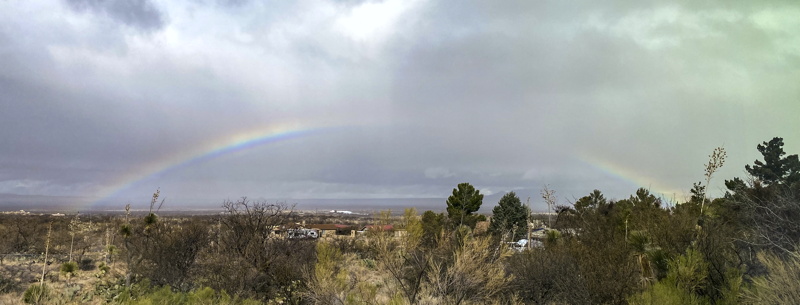Rainbows, Snow,
Asteroid Panopaea transits NGC3344 Galaxy
Posted: 17 March 2021
Thursday, 11 March 2021, dawned clear and calm, but clouds arrived mid-day along with strong wind (again). Early Friday morning, 12 March, there were two short rainbows (rainarcs?) in the western sky, followed by a full rainbow mid-morning.
0757 MST

0801 MST

0932 MST

There were periods of light rain and wind during the day on Friday and then late Friday night snow began with an accumulation of about 2" by sunrise on Saturday, 13 March.
0903 MST

The snow had mostly melted by Saturday afternoon. The sky cleared Sunday morning, 14 March, but it was windy during the daytime. As sunset approached the cloudy skies returned. Monday, 15 March, was cloudy and windy. Tuesday morning, 16 March, it snowed again, but it stopped mid-morning when the sky began to clear and the wind picked up again. As sunset approached the sky was clear and the wind decreased.
|
Open: Tuesday, 16 March 2021, 1823 MST Temperature: 55°F |
Session: 1609 Conditions: Clear, breezy |
Equipment:
12" f/8 LX600 w/StarLock
2" 24mm UWA eyepiece
Camera:
iPhone 11 Pro Max
D850 DSLR
1835 MST: sunset. Calm now.
1836 MST: LX600 ON, StarLock OFF, High Precision OFF.
Viewed the crescent Moon, 102X.
Began preparing the D850 DSLR for prime focus imaging.
1902 MST: took this handheld iPhone 11 Pro Max afocal 102X photo of the Moon using the iOS app NightCap Camera (ISO 32, 1/70sec, 1X lens).

Slewed to NGC3344 (galaxy). The galaxy was not yet visible in the twilight sky.
1926 MST: NGC3344 was now faintly visible, 102X.
1933 MST: mounted the D850 DSLR at prime focus of the 12" telescope, focused on the star Regulus, and locked the 12" mirror.
Slewed back to NGC3344.
1952 MST: StarLock ON.
2000-2030 MST: took seven StarLock autoguided images of NGC3344, 2 minutes, ISO 12800, White Balance 5560K, at 5 minute intervals.
2032 MST: StarLock OFF.
Of the seven images, autoguiding was bad on four of them due to the poor seeing this night. However, the other three, spaced at 10 minute intervals, were good.
This is the first image (full-frame) of Asteroid (70) Panopaea (Mag. +12.7) transiting the galaxy NGC3344 (Mag. +9.82).

Mouseover or tap on image for pointer to asteroid
The asteroid was 17 light-minutes from the Earth. The galaxy is 32 million light-years away. That's guite a difference in distance for these two objects.
This is an animated image (cropped from the full-frame images) showing the asteroid transiting the galaxy at 10 minute intervals.

Viewed NGC3344, 102X. The asteroid was not visible (moon light interfering probably).
2045 MST: LX600 OFF.
|
Close: Tuesday, 16 March 2021, 2053 MST Temperature: 37°F |
Session Length: 2h 30m Conditions: Clear |
On Friday, 19 March, 1915-2015pm MST (0215-0315 UT), Dr. John Barentine of the International Dark-Sky Association and I will be talking about the "Impacts of Satellite Mega-constellations" at the virtual Leprecon 47 convention. Register for free at the Leprecon web site to view this and the other panels at the convention.
Comments are welcome using Email. Twitter users can use the button below to tweet this report to their followers. Thanks.
Cassiopeia Observatory Home Page
Copyright ©2021 Michael L. Weasner / mweasner@me.com
URL = http://www.weasner.com/co/Reports/2021/03/17/index.html
